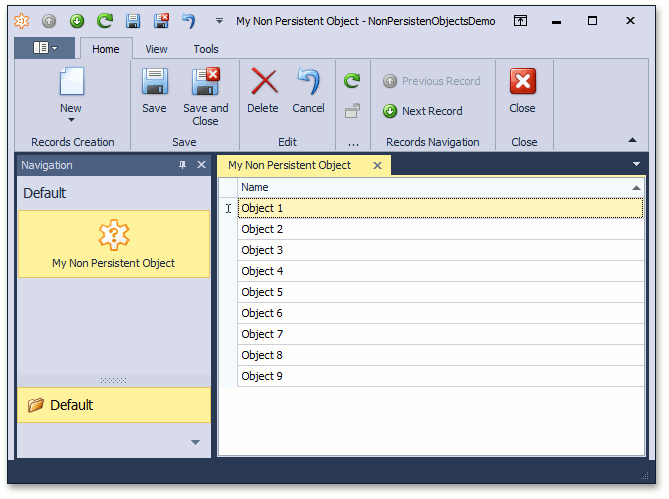How to: Display a Non-Persistent Object's List View from the Navigation
- 3 minutes to read
This example demonstrates how to display a non-persistent object‘s List View when a navigation item is chosen. Note that this approach is compatible with the Client data access mode only.
Declare a non-persistent class (e.g., MyNonPersistentObject), and decorate it with the DomainComponentAttribute and DefaultClassOptionsAttribute attributes.
using DevExpress.ExpressApp.DC; using DevExpress.Persistent.Base; // ... [DomainComponent, DefaultClassOptions] public class MyNonPersistentObject { // ... }Note
The INotifyPropertyChanged, IXafEntityObject and IObjectSpaceLink interface implementations were omitted in this example. However, it is recommended to support these interfaces in real-world applications (see PropertyChanged Event in Business Classes and Non-Persistent Objects).
Open the WinApplication.cs (WinApplication.vb), WebApplication.cs (WebApplication.vb), and/or MobileApplication.cs (MobileApplication.vb) file in a C#/VB Editor. Ensure that the NonPersistentObjectSpaceProvider is registered in the overridden CreateDefaultObjectSpaceProvider method (in addition to the existing XPObjectSpaceProvider or EFObjectSpaceProvider). The Solution Wizard adds this code automatically. Note that this code may be missing if you created your project in an older XAF version.
protected override void CreateDefaultObjectSpaceProvider(CreateCustomObjectSpaceProviderEventArgs args) { // ... args.ObjectSpaceProviders.Add(new NonPersistentObjectSpaceProvider(TypesInfo, null)); }If you now run the application, you will see that the My Non Persistent Object navigation item is created. It opens the List View which is empty, but you can create non-persistent objects with the New Action. If you reopen the List View, all created objects will, obviously, disappear.
You can fill the List View programmatically. Create a Window Controller. In the overridden OnActivated method subscribe to the XafApplication.ListViewCreating event. In the event handler, if the Collection Source’s object type is MyNonPersistentObject type, subscribe to the NonPersistentObjectSpace.ObjectsGetting event and populate the e.Objects collection as required.
using DevExpress.ExpressApp; // ... public class InitializeNonPersistentListViewWindowController : WindowController { public InitializeNonPersistentListViewWindowController() : base() { TargetWindowType = WindowType.Main; } protected override void OnActivated() { base.OnActivated(); Application.ListViewCreating += Application_ListViewCreating; } private void Application_ListViewCreating(Object sender, ListViewCreatingEventArgs e) { if ((e.CollectionSource.ObjectTypeInfo.Type == typeof(MyNonPersistentObject)) && (e.CollectionSource.ObjectSpace is NonPersistentObjectSpace)) { ((NonPersistentObjectSpace)e.CollectionSource.ObjectSpace).ObjectsGetting += ObjectSpace_ObjectsGetting; } } private void ObjectSpace_ObjectsGetting(Object sender, ObjectsGettingEventArgs e) { BindingList<MyNonPersistentObject> objects = new BindingList<MyNonPersistentObject>(); for (int i = 1; i < 10; i++) { objects.Add(new MyNonPersistentObject() { Name = string.Format("Object {0}", i) }); } e.Objects = objects; } protected override void OnDeactivated() { base.OnDeactivated(); Application.ListViewCreating -= Application_ListViewCreating; } }Tip
- You can also use the e.Sorting and e.Criteria arguments of the ObjectsGetting event to access sorting and filtering, respectively.
- In Mobile applications, the NonPersistentObjectSpace.ObjectByKeyGetting event should also be handled (see How to: Perform CRUD Operations with Non-Persistent Objects).
The result is demonstrated in the image below.

Tip
The New, Delete and Save Actions are available for non-persistent objects. To access all created, deleted and modified objects within NonPersistentObjectSpace, use the NonPersistentObjectSpace.ModifiedObjects property.